-
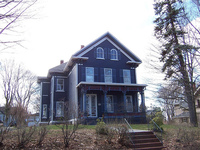 House at 15 Wave Avenue, Wakefield, Mass.
House at 15 Wave Avenue, Wakefield, Mass. Photos show the house located at 15 Wave Avenue on the south side of the street near the lake. Built between 1875 and 1883, the Italianate style house is of wood frame construction and originally had Henry Haskell's shoe factory located next door.
-
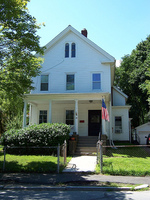 House at 15 Pleasant Street, Wakefield, Mass.
House at 15 Pleasant Street, Wakefield, Mass. Photo shows the house located at 15 Pleasant Street on the west side of the street at the corner of Otis Street. Built between 1865 and 1874, the Italianate style house was in 1874 the home of Otis W. Waterman, a lawyer and tax collector.
-
 House at 15 Nahant Street, Wakefield, Mass.
House at 15 Nahant Street, Wakefield, Mass. Photos show the house located at 15 Nahant Street on the south side of the street near the intersection with Main Street. The Georgian home was built as early as 1755, and was moved a short distance from its original location closer to the Nahant/Main Street intersection. The house has a rear ell and a two story "Beverly jog" on the east end.
-
 House at 15 Lawrence Street, Wakefield, Mass.
House at 15 Lawrence Street, Wakefield, Mass. Photo shows the house located at 15 Lawrence Street on the north side of the street near the intersection with Pleasant Street. Built around 1870-1874, the Queen Anne style house is of wood frame construction and has a carriage barn to the rear.
-
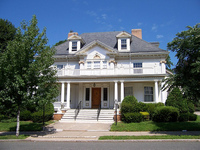 House at 15 Chestnut Street, Wakefield, Mass.
House at 15 Chestnut Street, Wakefield, Mass. Photos show views of the house located at 15 Chestnut Street on the north side of the street. Built around 1885, the Colonial Revival style house is of wood frame construction and was for a time used as a funeral home.
-
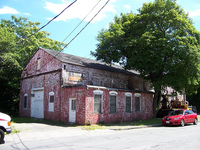 Car barn at 14 Valley Street, Wakefield, Mass.
Car barn at 14 Valley Street, Wakefield, Mass. Photo shows the former trolley car barns located at 14 Valley Street on the east side of the street near the intersection with Water Street. The brick structure was built around 1890 to serve the Water Street line of the Wakefield and Stoneham Street Railway Company. The large opening at the northwest end allowed trolley cars to enter the building for maintenance and repair. The building was used for many years as a garage for motor vehicle repair. It was demolished on July 23, 2018.
-
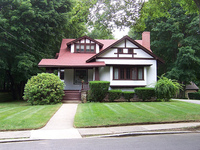 House at 13 Sheffield Road, Wakefield, Mass.
House at 13 Sheffield Road, Wakefield, Mass. Photos show views of the house located at 13 Sheffield Road on the east side of the street. The Craftsman style bungalow was built around 1918.
-
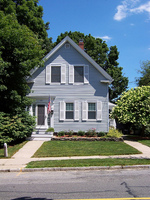 House at 131 Vernon Street, Wakefield, Mass.
House at 131 Vernon Street, Wakefield, Mass. Photo shows the house located at 131 Vernon Street on the east side of the street near Fitch Court. The simple Greek Revival style cottage was built between 1840 and 1856, and may have been built by its 1857 owner, carpenter Alexander Turnbull.
-
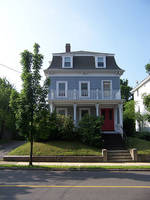 House at 12 West Water Street, Wakefield, Mass.
House at 12 West Water Street, Wakefield, Mass. Photos show the house located at 12 West Water Street on the south side of the street across from the intersection with Foster Street. The Second Empire style home has a mansard roof and was built around 1860.
-
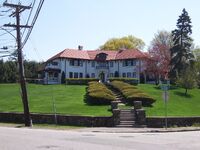 House at 127 Chestnut Street, Wakefield, Mass.
House at 127 Chestnut Street, Wakefield, Mass. Photos show the house located at 127 Chestnut Street on the southeast corner of the intersection with Prospect Street. Built around 1911, the English cottage style house has a stucco exterior and terra cotta tile roof. A three-car garage was recently added at the rear. The large, three-winged home was designed by Wakefield architect Harland O. Perkins, who lived at 8 Park Street. The home was built for Elizabeth Boit, one of the founders of the Harvard Knitting Mills, and was part of a compound of similarly styled buildings that included 90 Prospect Street, and a smaller carriage house at 88 Prospect Street.
-
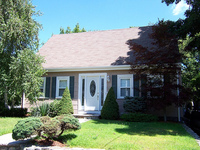 House at 125 Vernon Street, Wakefield, Mass.
House at 125 Vernon Street, Wakefield, Mass. Photo shows the house located at 125 Vernon Street on the east side of the street between Fitch Court and Emerald Street. The simple Cape style house was built between 1840 and 1845.
-
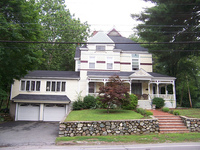 House at 123 Greenwood Street, Wakefield, Mass.
House at 123 Greenwood Street, Wakefield, Mass. Photos show views of the house located at 123 Greenwood Street on the west side of the street at the corner of Cherry Lane. The Queen Anne Style house is clad in elaborately patterned shingles. It sits on land that was once part of the Reuben Green Farm, which is still extant nearby at the corner of Spring Street. The neighborhood was known in the late 19th century as Boyntonville after a local family.
-
 House at 122 Chestnut Street, Wakefield, Mass.
House at 122 Chestnut Street, Wakefield, Mass. Photos show the house located at 122 Chestnut Street on the west side of the street near Park Avenue. This elaborately detailed Queen Anne/Shingle Style house, with Colonial Revival motifs, was built around 1885. It is of wood frame construction and has a shingle exterior adorned with carved and terra cotta panels. The house is at the entrance to the Wakefield Park neighborhood, the development of which began in 1886. The area was promoted as having a healthful and beautiful environment, with elegant homes and building restrictions.
-
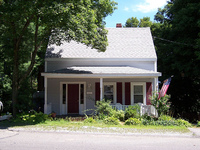 House at 121 Vernon Street, Wakefield, Mass.
House at 121 Vernon Street, Wakefield, Mass. Photo shows the house located at 121 Vernon Street on the east side of the street between Fitch Court and Emerald Street. The simple Queen Anne style house was built between 1890 and 1910 and probably replaced an earlier house on the site.
-
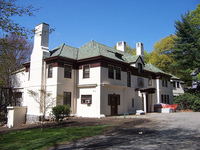 Temple Emmanuel at 120 Chestnut Street, Wakefield, Mass.
Temple Emmanuel at 120 Chestnut Street, Wakefield, Mass. Photos show the house located at 120 Chestnut Street on the west side of the street near Park Avenue. The English Cottage Style house was built between 1915 and 1920. It has a stucco exterior and green tile roof. The site was originally occupied by a Shingle Style house which was moved nearby to 18 Park Avenue and is still extant. This structure was built as a private home, and was the residence of Congressman Harry I. Thayer in 1923. It has been used as a house of worship for the Temple Emmanuel congregation since 1951, when the house was purchased from the Yuell family estate. Extensive renovations were done on the house, and the new sanctuary was dedicated in 1952. The building stands at the entrance to the Wakefield Park neighborhood, the development of which began in 1886. The area was promoted as having a healthful and beautiful environment, with elegant homes and building restrictions.
-
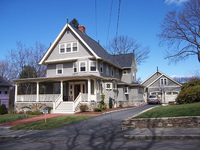 House at 11 White Avenue, Wakefield, Mass.
House at 11 White Avenue, Wakefield, Mass. Photos show the house located at 11 White Avenue on the north side of the street near the lake. The Queen Anne style house is of wood frame construction with a shingle exterior.
-
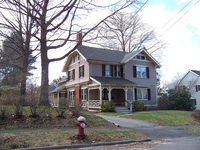 House at 11 Wave Avenue, Wakefield, Mass.
House at 11 Wave Avenue, Wakefield, Mass. Photos show the house located at 11 Wave Avenue on the south side of the street near the lake. Built between 1875 and 1888, the Queen Anne/stick style house is of wood frame construction and has a carriage house at the rear.
-
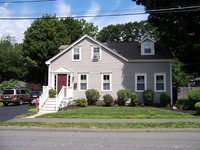 House at 11 Eaton Street, Wakefield, Mass.
House at 11 Eaton Street, Wakefield, Mass. Photos show views of the house located at 11 Eaton Street on the north side of the street. The house was built around 1810, and was owned in the late 19th century by the Ripley family.
-
 House at 11 Chestnut Street, Wakefield, Mass.
House at 11 Chestnut Street, Wakefield, Mass. Photos show views of the house located at 11 Chestnut Street on the north side of the street near Main Street. The Italianate Style house was built between 1850 and 1855. It has two interior chimneys at the rear. The house was owned in the 1870s by A. C. Perkins, who also owned the nearby house at 7 Chestnut Street.
-
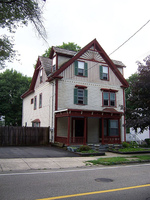 House at 118 Greenwood Street, Wakefield, Mass.
House at 118 Greenwood Street, Wakefield, Mass. Photos show views of the house located at 118 Greenwood Street on the east side of the street near the corner of Spring Street. The Stick Style house was built around 1875. The house sits on land that was once part of the Reuben Green Farm, which is still extant nearby at the corner of Spring Street. The neighborhood was known in the late 19th century as Boyntonville after a local family.
-
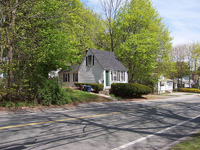 House at 113 Salem Street, Wakefield, Mass.
House at 113 Salem Street, Wakefield, Mass. Photos show the house located at 113 Salem Street on the north side of the street near the intersection with Vernon Street. Built between 1840 and 1857, the small building was originally a shoe shop owned by David Nichols. At only 660 square feet, it may well be the smallest house in Wakefield.
-
 House at 10 Melvin Street, Wakefield, Mass.
House at 10 Melvin Street, Wakefield, Mass. Photos show views of the house located at 10 Melvin Street on the east side of the street near Water Street. The Italianate style house was built between 1912 and 1920 and is now clad in asbestos shingles and contains apartments.
-
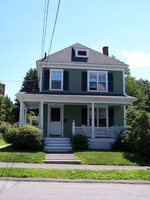 House at 10 Eaton Street, Wakefield, Mass.
House at 10 Eaton Street, Wakefield, Mass. Photos show views of the house located at 10 Eaton Street on the south side of the street. Porter Smith originally owned the property now comprising 10 and 12 Eaton Streets. Around 1890, he split the land into two lots, building and moving into what is now 12 Eaton Street. This adjacent house at number 10 was built sometime between 1891 and 1898. From 1899 to 1924 it was occupied by Frank W. Smith. The home is most closely identified with the Spaulding and Bonney families, connected with the Bonney & Dutton Drug Store, who lived there from 1931 through 1953.
-
 House at 10 Crescent Street, Wakefield, Mass.
House at 10 Crescent Street, Wakefield, Mass. Photos show the house located at 10 Crescent Street on the east side of the street near the intersection with Main Street. Built around 1785, the Federal style house has a large recent addition to the north and is clad in vinyl siding. The property was originally the home of Lilley Eaton, Sr. , and was later divided into two homes. It is now used as professional office space.
-
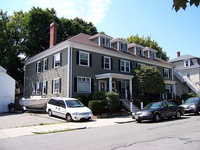 House at 10 Avon Street, Wakefield, Mass.
House at 10 Avon Street, Wakefield, Mass. Photos show views of the house located at 10 Avon Street on the south side of the street near Main Street. The Colonial Revival Style house was built in the 1880s as a double house. It now contains apartments.
-
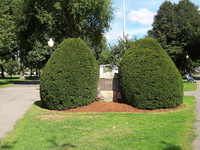 World War I memorial, Wakefield, Mass.
World War I memorial, Wakefield, Mass. Photos show views of the granite memorial with a bronze plaque listing Wakefield's casualties in the Great War. The monument is located near the south end of the Upper Common.
-
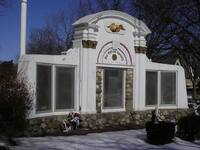 World War II Monument, Wakefield, Mass.
World War II Monument, Wakefield, Mass. Photos show views of the World War Two Memorial on the Common approximately opposite Park Street, financed by citizens' donations to commemorate Wakefield's casualties. The monument was sponsored by the Corporal Harry E. Nelson Post 63, American Legion, and designed by John H. Rogers.
-
 House at 316 Main Street, Wakefield, Mass.
House at 316 Main Street, Wakefield, Mass. Photos show views of the Benjamin B. Wiley house located at 316 Main Street facing the Rockery. Built in 1822 in the Federal style, it is made of brick and has a wooden carriage house in the rear. ;
-
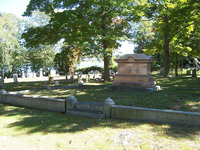 Wakefield family plot, Lakeside Cemetery, Wakefield, Mass.
Wakefield family plot, Lakeside Cemetery, Wakefield, Mass. Photos show views of the Wakefield family plot in Lakeside Cemetery on North Avenue. The plot with its red granite tomb is located near the corner of "South Avenue" and "Dielytra Path" at the southeast corner of the cemetery near the lake. The Cyruses buried here are not the one for whom the town is named, but rather the first Cyrus' nephew and his son and grandson. Confusingly, Cyrus II's son and grandson were both known as Cyrus Jr. The better known Cyrus, for whom Wakefield is named, is buried in a separate tomb with his wife Eliza elsewhere in the same cemetery. Also buried here is Jasper Young Wakefield, the fourth child of Cyrus II, who "Died June 11, 1883 aged 4 years 11 mos. & 12 days. "
-
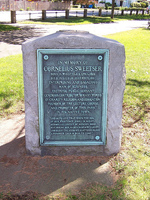 Cornelius Sweetser memorial, Wakefield, Mass.
Cornelius Sweetser memorial, Wakefield, Mass. Photos show views of the granite historical marker located at the extreme northeast corner of the Upper Common at the corner of Main and Church Streets.
-
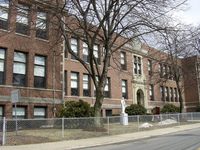 Saint Joseph School, Wakefield, Mass.
Saint Joseph School, Wakefield, Mass. Photos show the Saint Joseph Catholic School at 15 Gould Street in Wakefield. The school is affiliated with St. Joseph's Roman Catholic parish and serves children from pre-kindergarten through 8th grade.
-
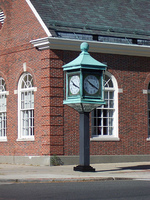 Wakefield Savings Bank clock, Wakefield, Mass.
Wakefield Savings Bank clock, Wakefield, Mass. Photos show the freestanding clock located in front of the Wakefield Savings Bank at the corner of Main and Chestnut Streets. The clock was built around 1902 and is made of steel, copper, and glass.
-
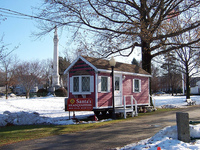 Santa's Headquarters, Wakefield, Mass.
Santa's Headquarters, Wakefield, Mass. Photos show views of the temporary trailer where children can visit Santa Claus each afternoon and evening during the pre Christmas season. The trailer is sponsored by the Wakefield Lions' Club and is located on the Upper Common each December.
-
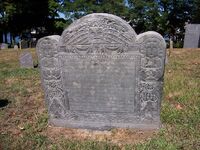 Jonathan Pierpont headstone, Old Burying Ground, Wakefield, Mass.
Jonathan Pierpont headstone, Old Burying Ground, Wakefield, Mass. Photos show the Jonathan Pierpont grave stone in the Old Burying Ground on Church Street. Pierpont was the fourth minister in Redding, where he was ordained in 1689. The slate headstone was carved by Joseph Lamson, the foremost carver of the Puritan period, and is widely considered one of the best examples of Puritan cemetery carving in the United States. It is located at the east end of the cemetery, close to the Congregational Church.
-
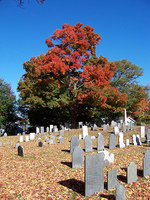 Old Burying Ground, Wakefield, Mass. , in autumn
Old Burying Ground, Wakefield, Mass. , in autumn Photos show various views of the Old Burying Ground on Church Street. The cemetery includes the earliest gravestones in Wakefield, from the late 17th century, although the majority of stones date from the 18th and 19th centuries. The last death date is 1926. There are approximately 600 stones in the burial ground. ;
-
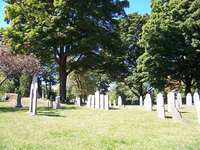 Old Burying Ground, Wakefield, Mass.
Old Burying Ground, Wakefield, Mass. Photos show various views of the Old Burying Ground on Church Street. The cemetery includes the earliest gravestones in Wakefield, from the late 17th century, although the majority of stones date from the 18th and 19th centuries. The last death date is 1926. There are approximately 600 stones in the burial ground.
-
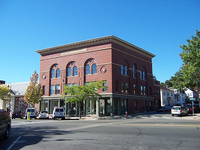 Odd Fellows Building at 349-353 Main Street, Wakefield, Mass.
Odd Fellows Building at 349-353 Main Street, Wakefield, Mass. Photos show the Odd Fellows Building, also known as Flanley's Block, located at 349-353 Main Street at the corner of Avon Street. The brick building was built circa 1895-1898 in the Renaissance revival style. Wakefield furniture dealer John Flanley originally built the structure, but it was taken over by the Odd Fellows fraternal organization in 1918. On January 24, 1997, the building was gutted by a major fire, believed to have started in a second floor office. The structure was subsequently restored and renovated for office space by the adjacent Wakefield Savings Bank.
-
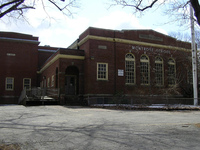 Montrose School, Wakefield, Mass.
Montrose School, Wakefield, Mass. Photos show the Montrose School on Salem Street near Wharton Park in the Montrose section of Wakefield. The school was built in 1918 and remodeled and enlarged in 1930.
-
 Lincoln School, Wakefield, Mass.
Lincoln School, Wakefield, Mass. Photos show views of the Lincoln School, built in 1895 in the Romanesque revival style. It is located at the corner of Crescent and Otis Streets. The building is how used for elderly housing under the aegis of the Wakefield Housing Authority.
-
 Chapel, Lakeside Cemetery, Wakefield, Mass.
Chapel, Lakeside Cemetery, Wakefield, Mass. Photos show views of the chapel in Lakeside Cemetery on North Avenue, on the west shore of Lake Quannapowitt. The cemetery was established in 1846, and the Gothic chapel, designed by architect Edward M. Bridge, was built in 1932. After several land acquisitions, the cemetery is now about 22 acres in size.
-
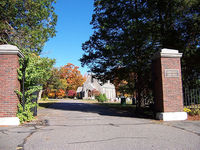 Lakeside Cemetery, Wakefield, Mass.
Lakeside Cemetery, Wakefield, Mass. Photos show views of Lakeside Cemetery on North Avenue, on the west shore of Lake Quannapowitt. The cemetery was established in 1846, and its Gothic chapel was built in 1932. After several land acquisitions, the cemetery is now about 22 acres in size.
-
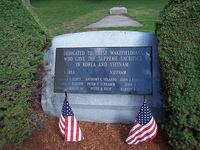 Korean War and Vietnam War memorial, Wakefield, Mass.
Korean War and Vietnam War memorial, Wakefield, Mass. Photos show front and rear views of the granite memorial with a bronze plaque listed Wakefield's casualties in the two wars. The monument is located at the extreme south end of the Upper Common.
-
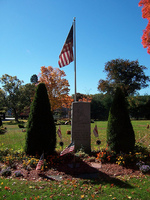 Fire fighters' memorial, Lakeside Cemetery, Wakefield, Mass.
Fire fighters' memorial, Lakeside Cemetery, Wakefield, Mass. Photos show views of the granite memorial with a bronze plaque listing Wakefield's firefighters who have died. The monument is located near the chapel at the entrance to Lakeside Cemetery on North Avenue.
-
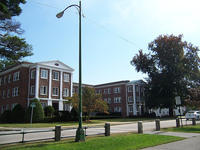 Crystal Apartments at 294-298 Main Street, Wakefield, Mass.
Crystal Apartments at 294-298 Main Street, Wakefield, Mass. Photos show views of the Crystal Apartment building located at 294-298 Main Street facing the Common between Park and Crescent Streets. Built in 1924 by John S. Griffiths in the neo-Federal style, it was the largest apartment building in Wakefield at the time.
-
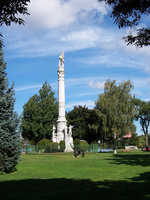 Soldiers' and Sailors' Monument, Wakefield, Mass.
Soldiers' and Sailors' Monument, Wakefield, Mass. Photos show views of the Soldiers and Sailors Memorial, a granite column erected in 1902 to commemorate Wakefield's Civil War casualties. The monument is located on the Common approximately opposite Bryant Street. It was funded by a $10,000 bequest from the will of local resident Harriet Newell Flint. The band stand is visible in the background of the first photo. "Given to the town of Wakefield by Harriet Newell Flint" - text from north side of monument. "To the men of South Reading who gave their lives to keep the states united 1861-1865" - text from south side of monument. Monument lists the battles in which Wakefield soldiers participated: New Berne, Malvern Hill, Chancellorsville, Weldon Railroad, Fort Fisher, Charleston, Brandy Station, Resaca, Appomattox, Andersonville, Bull Run, Balls Bluff, Fredericksburg, Wilderness, Petersburg, Antietam, Port Hudson, Aldie, Gettysburg, Spottsylvania.
-
 Beebe family plot, Lakeside Cemetery, Wakefield, Mass.
Beebe family plot, Lakeside Cemetery, Wakefield, Mass. Photos show views of the Beebe family plot in Lakeside Cemetery on North Avenue. The plot is located near the corner of "Elm Avenue" and "Gooseberry Path" at the eastern edge of the cemetery near the lake.
-
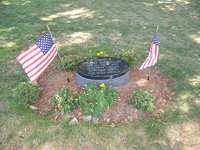 September 11 Terrorist Attacks memorial, Wakefield, Mass.
September 11 Terrorist Attacks memorial, Wakefield, Mass. Photos show views of the 9/11 memorial located at the corner of Main and Church Streets on the southeast corner of the Lower Common.
-
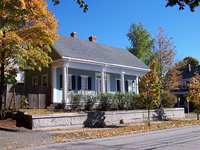 House at 40 Crescent Street, Wakefield, Mass.
House at 40 Crescent Street, Wakefield, Mass. Photos show views of the house located at 40 Crescent Street on the east side of the street. Built in 1839, the Greek Revival house is known as the Abel F. Hutchinson house after its builder, a shoe maker.
-
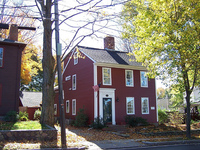 House at 40 Church Street, Wakefield, Mass.
House at 40 Church Street, Wakefield, Mass. Photos show views of the house located at 40 Church Street on the south side of the street opposite the Hartshorne House. Built around 1804, the Federal style house is known as the Ebenezer Wiley house after its builder. The house was constructed from a tin shop which was located on the site.
-
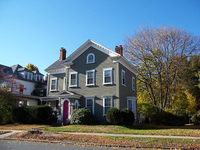 House at 3 Common Street, Wakefield, Mass.
House at 3 Common Street, Wakefield, Mass. Photos show views of the house located at 3 Common Street on the west side of the Upper Common. Built around 1855, the Italianate house is of wood frame construction. It was built by John Francis Hartshorne, the son of Colonel James Hartshorne who lived on nearby Church Street in the Hartshorne House.
-
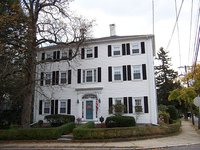 House at 34 Salem Street, Wakefield, Mass.
House at 34 Salem Street, Wakefield, Mass. Photos show views of the house located at 34 Salem Street on the southeast corner of the intersection with Pleasant Street. Built around 1819-1820, the large Federal style house was build by contractor Elias Boardman, who had also done construction work on Beacon Hill in Boston. The house was considered so extravagant at the time that it was known locally as "Boardman's Folly". A rear ell and garage were added later. The home is now broken into apartments.
-
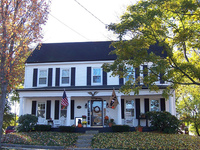 House at 34 Lafayette Street, Wakefield, Mass.
House at 34 Lafayette Street, Wakefield, Mass. Photos show views of the house located at 34 Lafayette Street on the south side of the street near the intersection with Church Street. Built around 1835, the Federal style house is of wood frame construction and has a Greek Revival style front porch which has a view of Lake Quannapowitt.
-
 House at 284 Main Street, Wakefield, Mass.
House at 284 Main Street, Wakefield, Mass. Photos show the house located at 284 Main Street at the corner of Park Street. Built in 1931, the house is of multicolored brick construction and faces the Upper Common.
-
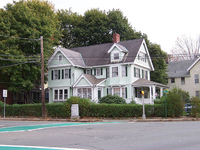 House at 266 Main Street, Wakefield, Mass.
House at 266 Main Street, Wakefield, Mass. Photos show the house located at 266 Main Street at the southeast corner of the interesection with Salem Street. Built in 1903, the five bedroom Queen Anne style house is of wood construction and overlooks the Common. It is now clad in vinyl siding.
-
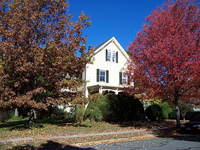 House at 25 Yale Avenue, Wakefield, Mass.
House at 25 Yale Avenue, Wakefield, Mass. Photos show views of the house located at 25 Yale Avenue on the north side of the street. Built around 1865, the home is a typical example of the Italianate style.
-
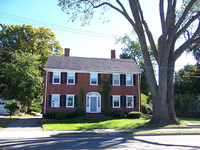 House at 252 Main Street, Wakefield, Mass.
House at 252 Main Street, Wakefield, Mass. Photos show the house located at 252 Main Street. Built around 1818, the Federal style house is of brick construction and overlooks the Lower Common. The house was originally built for a member of the well-known Eaton family and has Rufus Porter murals on the living room walls.
-
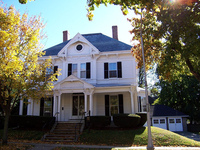 House at 24 Yale Avenue, Wakefield, Mass.
House at 24 Yale Avenue, Wakefield, Mass. Photos show views of the house located at 24 Yale Avenue on the south side of the street. Built around 1863, the Italianate and stick style house now houses legal offices. A carriage house and garage are located to the rear of the main home.
-
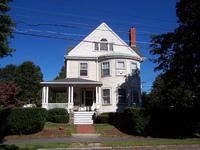 House at 23 Lawrence Street, Wakefield, Mass.
House at 23 Lawrence Street, Wakefield, Mass. Photo shows the house located at 23 Lawrence Street at the corner of Pleasant Street. Built around 1890, the Colonial revival style house is of wood frame construction and has a garage and barn.
-
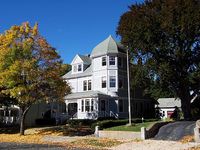 House at 21 Yale Avenue, Wakefield, Mass.
House at 21 Yale Avenue, Wakefield, Mass. Photos show views of the house located at 21 Yale Avenue on the north side of the street. Built around 1870, the house is of wood frame construction and is a good example of the Queen Anne style.
-
 House at 21 Chestnut Street, Wakefield, Mass.
House at 21 Chestnut Street, Wakefield, Mass. Photos show views of the house located at 21 Chestnut Street on the north side of the street. Built around 1850, the Italianate house is of wood frame construction and was once owned by Frank and Ruth Woodbury, who were active in town history and affairs. The house was designed by architect John Stevens.
-
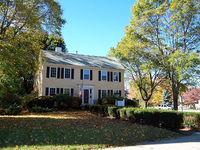 House at 1 Common Street, Wakefield, Mass.
House at 1 Common Street, Wakefield, Mass. Photos show views of the house located at 1 Common Street on the west side of the Upper Common. Built between 1812 and 1820, the Federal style house now houses legal offices. A garage and outbuilding are located in the rear. 7. ;
-
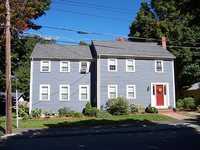 House at 15 Eaton Street, Wakefield, Mass.
House at 15 Eaton Street, Wakefield, Mass. Photos show views of the house located at 15 Eaton Street on the north side of the street. Built in 1840, the house is of wood frame construction and has several additions.
-
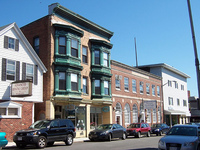 Building at 13-15 Albion Street, Wakefield, Mass.
Building at 13-15 Albion Street, Wakefield, Mass. Photos show views of the building located at 13-15 Albion Street on the north side of the street. Built around 1906, the yellow brick building has businesses on the ground floor and apartments above. It is in Renaissance revival style and has four copper-clad bay windows on the upper floors.
-
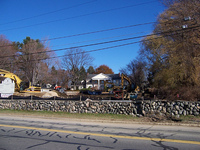 House at 120 Main Street, Wakefield, Mass.
House at 120 Main Street, Wakefield, Mass. Photos show views of the house formerly located at 120 Main Street facing Lake Quannapowitt. The house was built around 1948 and was of wood construction with a brick exterior. The front of the house had a large portico with four Ionic columns. The home was demolished in December 2007 to make way for a 12-lot subdivision called Carriage Lane.
-
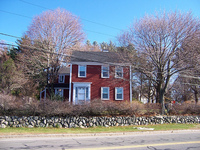 House at 114 Main Street, Wakefield, Mass.
House at 114 Main Street, Wakefield, Mass. Photos show views of the house located at 114 Main Street facing Lake Quannapowitt. Built before 1750, the house is of wood frame construction and was built by Dr. Thomas Simpson.
-
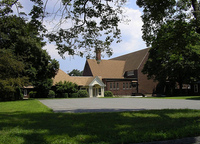 Most Blessed Sacrament Roman Catholic Church at 1155 Main Street, Wakefield, Mass.
Most Blessed Sacrament Roman Catholic Church at 1155 Main Street, Wakefield, Mass. Photos show views of the Most Blessed Sacrament Catholic Church at 1155 Main Street on the west side of the street opposite Coolidge Park in the Greenwood section of Wakefield. After holding Masses for years at the local fire station, Catholics in the Greenwood section of Wakefield succeeded in raising enough money to build a proper chapel, where the first Mass was celebrated in the Shingle Style church in 1927. It remained a "mission" church of St. Joseph's until 1931, when a new parish was announced including Greenwood and parts of Melrose and Saugus. The wings were added in the 1940s and the building was expanded further in the late 20th century.
-
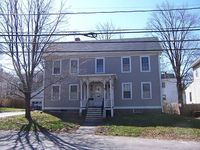 House at 12 Salem Street, Wakefield, Mass.
House at 12 Salem Street, Wakefield, Mass. Photos show the house located at 12 Salem Street on the south side of the street near the Common. Built between 1831 and 1873, the Federal style house has an Italianate porch which was probably added in the 1860s or 1870s. In 1874 it was the home of Daniel Swett.
-
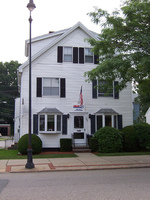 Building at 306 Main Street, Wakefield, Mass.
Building at 306 Main Street, Wakefield, Mass. Photos show views of the building located at 306 Main Street on the east side of the street at the corner of Crescent Street. The building also incorporates 1 Crescent Street. It was originally built as a shoe factory around 1800 by Benjamin Wiley, who later built the adjacent brick house in 1822. He converted this building to his home in 1850 after selling the brick house to his son Ebenezer. It is currently used for professional offices and apartments.
-
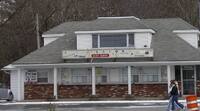 Montrose drive-in, Wakefield, Mass.
Montrose drive-in, Wakefield, Mass. Photo shows the Montrose drive-in restaurant and ice cream stand, also known as the Montrose dairy, located on Salem Street opposite Audubon Road. The building was demolished in September 2007 to make way for a Dunkin Donuts.
-
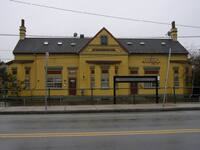 Train station, North Avenue, Wakefield, Mass.
Train station, North Avenue, Wakefield, Mass. Photo shows the MBTA railroad depot between North Avenue and Tuttle Street in Wakefield. The building opened in 1890 and was known as the Upper Depot. For many years the brick structure was painted red, but in 2006 it was repainted with the current Victorian era color scheme. It now contains office and business space.
-
 Most Blessed Sacrament Roman Catholic Church, Wakefield, Mass.
Most Blessed Sacrament Roman Catholic Church, Wakefield, Mass. Photo shows Most Blessed Sacrament Roman Catholic Church at 1155 Main Street in the Greenwood section of Wakefield. Th church was built in the shingle style in 1927 and has been enlarged since then.
-
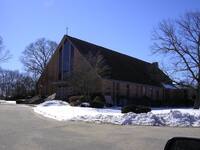 St. Florence's Roman Catholic Church, Wakefield, Mass.
St. Florence's Roman Catholic Church, Wakefield, Mass. Photo shows Saint Florence's Roman Catholic Church at 47 Butler Avenue. The church was built in 1960.
-
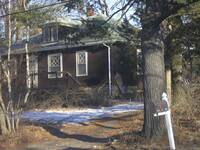 Studio School, Wakefield, Mass.
Studio School, Wakefield, Mass. Photo shows the Studio School in Wakefield.
-
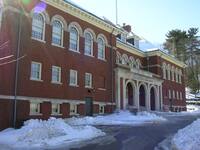 Warren School/McCarthy Senior Center, Wakefield, Mass.
Warren School/McCarthy Senior Center, Wakefield, Mass. Photo shows the Warren School at 30 Converse Street on the West Side of Wakefield. The school was built in 1895, and now houses the town's senior center, run by the Wakefield Council on Aging.
-
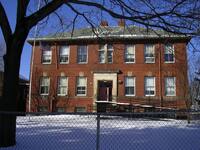 Hurd School, Wakefield, Mass.
Hurd School, Wakefield, Mass. Photo shows the Hurd School on the northwest corner of Cordis and Pleasant Streets in the North Ward section of Wakefield. The school was built in 1898. It closed in the early 2000s.
-
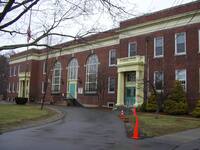 Greenwood School, Wakefield, Mass.
Greenwood School, Wakefield, Mass. Photo shows the Greenwood School on the east side of Main Street, number 1030 in the Greenwood section of Wakefield. The school was built in 1897, and remodeled and enlarged in 1902 and again in 1924.
-
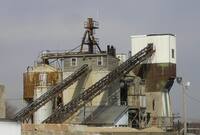 Wakefield Ready Mixed Concrete Company, Wakefield, Mass.
Wakefield Ready Mixed Concrete Company, Wakefield, Mass. Photo depicts the Wakefield Ready Mixed Concrete Company plant located at 1 New Salem Street.
-
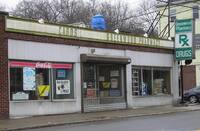 Greenwood Pharmacy, Wakefield, Mass.
Greenwood Pharmacy, Wakefield, Mass. Photo depicts the Greenwood Pharmacy located at 949 Main Street. The pharmacy was owned by the Velardo family for over 50 years at that location. It closed on Wednesday, December 26, 2007.
-
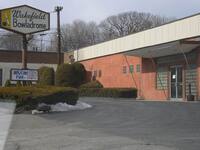 Wakefield Bowladrome, Wakefield, Mass.
Wakefield Bowladrome, Wakefield, Mass. Photo depicts the Wakefield Bowladrome located at 92 Water Street.
-
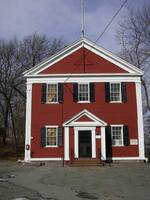 West Ward School, Wakefield, Mass.
West Ward School, Wakefield, Mass. The West Ward School, also known as the "Little Red Schoolhouse", was built in 1847. It is located on Prospect Street at the intersection with Elm Street.
-
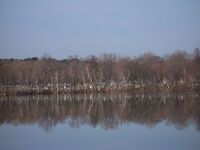 Lakeside Cemetery, Wakefield, Mass.
Lakeside Cemetery, Wakefield, Mass. Photo shows a view of Lakeside Cemetery on North Avenue, on the west shore of Lake Quannapowitt. This view was taken from the eastern shore of the Lake, near the intersection of Main and Sweetser Streets. The cemetery was established in 1846, and its Gothic chapel was built in 1932. After several land acquisitions, the cemetery is now about 22 acres in size.
-
 William Hescy headstone, Old Burying Ground, Wakefield, Mass.
William Hescy headstone, Old Burying Ground, Wakefield, Mass. Photo shows the William Hescy grave stone in the Old Burying Ground on Church Street. The stone is located at the west end of the cemetery.
-
 William Green headstone, Old Burying Ground, Wakefield, Mass.
William Green headstone, Old Burying Ground, Wakefield, Mass. Photo shows the William Green grave stone in the Old Burying Ground on Church Street. The stone is located at the east end of the cemetery
-
 Thomas Parker headstone, Old Burying Ground, Wakefield, Mass.
Thomas Parker headstone, Old Burying Ground, Wakefield, Mass. Photo shows the Thomas Parker grave stone in the Old Burying Ground on Church Street. The stone is located at the west end of the cemetery.
-
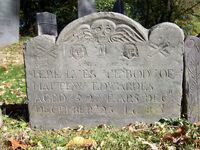 Matthew Edwardes headstone, Old Burying Ground, Wakefield, Mass.
Matthew Edwardes headstone, Old Burying Ground, Wakefield, Mass. Photo shows the Matthew Edwardes grave stone in the Old Burying Ground on Church Street. The stone is located at the east end of the cemetery.
-
 Sarah Briant [i. e. Bryant] headstone, Old Burying Ground, Wakefield, Mass.
Sarah Briant [i. e. Bryant] headstone, Old Burying Ground, Wakefield, Mass. Photo shows the Sarah Briant grave stone in the Old Burying Ground on Church Street.
-
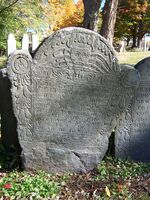 Elizabeth Browne headstone, Old Burying Ground, Wakefield, Mass.
Elizabeth Browne headstone, Old Burying Ground, Wakefield, Mass. Photo shows the Elizabeth Browne grave stone in the Old Burying Ground on Church Street. The stone is located at the west end of the cemetery.
-
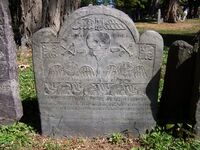 Thomas Kendel [i. e. Kendall] headstone, Old Burying Ground, Wakefield, Mass.
Thomas Kendel [i. e. Kendall] headstone, Old Burying Ground, Wakefield, Mass. Photo shows the Deacon Thomas Kendel grave stone in the Old Burying Ground on Church Street. The slate headstone was carved by the "Charlestown Carver", and is considered one of the earliest and best examples of Puritan cemetery carving in New England. Various sources date the stone to 1678, although others record Kendall's death in 1684.
-
 House at 21 Park Avenue, Wakefield, Mass.
House at 21 Park Avenue, Wakefield, Mass. Photo shows the house located at 21 Park Avenue on the north side of the street near Dell Avenue. The house is in the Wakefield Park neighborhood, the development of which began in 1886. The area was promoted as having a healthful and beautiful environment, with elegant homes and building restrictions.
-
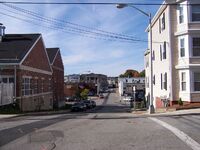 View of Centre Street looking west, 2007
View of Centre Street looking west, 2007 Photo shows a view of Centre Street looking west from Crescent Street towards Main Street. On the left is the 2004 Public Safety Building. In the middle ground the rear of CVS pharmacy can be seen on the left, and the rear of Alano department store on the right. In the far distance, on Main Street the tops of the Bourdon (Kingman) Block and Sovereign Bank are visible.
-
 View of Princess Street looking west, 2007
View of Princess Street looking west, 2007 Photo shows a view of Princess Street (originally Mechanic Street) looking west from Crescent Street towards Main Street. On the right is the 2004 Public Safety Building, with the 1891 brick hose drying tower visible.
-
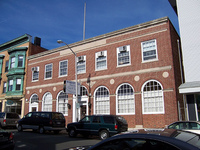 Wakefield Municipal Gas & Light Department building
Wakefield Municipal Gas & Light Department building Photo shows a view of the building housing the offices of the Wakefield Municipal Gas & Light Department, located at 9 Albion Street on the north side of the street. The brick building was built for the Wakefield Post Office in 1924 and used by them until 1937. The WMGLD purchased it in 1947.
-
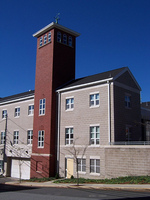 Hose drying tower, Public Safety Building, Wakefield, Mass.
Hose drying tower, Public Safety Building, Wakefield, Mass. Photo shows the brick hose drying tower, originally part of the 1891 central fire station at the corner of Crescent and Princess Streets. The tower was the only part of the building that was saved and incorporated into the new Public Safety Building, housing both the police and fire departments, which opened March 31, 2004.
-
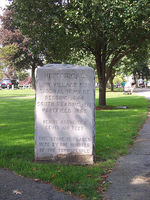 Historical marker, Wakefield, Mass.
Historical marker, Wakefield, Mass. Photo shows a view of the granite historical marker located at the extreme south end of the Upper Common. "Historical Linn Village 1639, Original town of Redding 1644, South Reading 1812, Wakefield 1868, Height above sea level 120 feet, This stone is placed here by one hundred of the townspeople A. D. 1909" - text from south (front) side of monument.
 House at 15 Wave Avenue, Wakefield, Mass. Photos show the house located at 15 Wave Avenue on the south side of the street near the lake. Built between 1875 and 1883, the Italianate style house is of wood frame construction and originally had Henry Haskell's shoe factory located next door.
House at 15 Wave Avenue, Wakefield, Mass. Photos show the house located at 15 Wave Avenue on the south side of the street near the lake. Built between 1875 and 1883, the Italianate style house is of wood frame construction and originally had Henry Haskell's shoe factory located next door. House at 15 Pleasant Street, Wakefield, Mass. Photo shows the house located at 15 Pleasant Street on the west side of the street at the corner of Otis Street. Built between 1865 and 1874, the Italianate style house was in 1874 the home of Otis W. Waterman, a lawyer and tax collector.
House at 15 Pleasant Street, Wakefield, Mass. Photo shows the house located at 15 Pleasant Street on the west side of the street at the corner of Otis Street. Built between 1865 and 1874, the Italianate style house was in 1874 the home of Otis W. Waterman, a lawyer and tax collector. House at 15 Nahant Street, Wakefield, Mass. Photos show the house located at 15 Nahant Street on the south side of the street near the intersection with Main Street. The Georgian home was built as early as 1755, and was moved a short distance from its original location closer to the Nahant/Main Street intersection. The house has a rear ell and a two story "Beverly jog" on the east end.
House at 15 Nahant Street, Wakefield, Mass. Photos show the house located at 15 Nahant Street on the south side of the street near the intersection with Main Street. The Georgian home was built as early as 1755, and was moved a short distance from its original location closer to the Nahant/Main Street intersection. The house has a rear ell and a two story "Beverly jog" on the east end. House at 15 Lawrence Street, Wakefield, Mass. Photo shows the house located at 15 Lawrence Street on the north side of the street near the intersection with Pleasant Street. Built around 1870-1874, the Queen Anne style house is of wood frame construction and has a carriage barn to the rear.
House at 15 Lawrence Street, Wakefield, Mass. Photo shows the house located at 15 Lawrence Street on the north side of the street near the intersection with Pleasant Street. Built around 1870-1874, the Queen Anne style house is of wood frame construction and has a carriage barn to the rear. House at 15 Chestnut Street, Wakefield, Mass. Photos show views of the house located at 15 Chestnut Street on the north side of the street. Built around 1885, the Colonial Revival style house is of wood frame construction and was for a time used as a funeral home.
House at 15 Chestnut Street, Wakefield, Mass. Photos show views of the house located at 15 Chestnut Street on the north side of the street. Built around 1885, the Colonial Revival style house is of wood frame construction and was for a time used as a funeral home. Car barn at 14 Valley Street, Wakefield, Mass. Photo shows the former trolley car barns located at 14 Valley Street on the east side of the street near the intersection with Water Street. The brick structure was built around 1890 to serve the Water Street line of the Wakefield and Stoneham Street Railway Company. The large opening at the northwest end allowed trolley cars to enter the building for maintenance and repair. The building was used for many years as a garage for motor vehicle repair. It was demolished on July 23, 2018.
Car barn at 14 Valley Street, Wakefield, Mass. Photo shows the former trolley car barns located at 14 Valley Street on the east side of the street near the intersection with Water Street. The brick structure was built around 1890 to serve the Water Street line of the Wakefield and Stoneham Street Railway Company. The large opening at the northwest end allowed trolley cars to enter the building for maintenance and repair. The building was used for many years as a garage for motor vehicle repair. It was demolished on July 23, 2018. House at 13 Sheffield Road, Wakefield, Mass. Photos show views of the house located at 13 Sheffield Road on the east side of the street. The Craftsman style bungalow was built around 1918.
House at 13 Sheffield Road, Wakefield, Mass. Photos show views of the house located at 13 Sheffield Road on the east side of the street. The Craftsman style bungalow was built around 1918. House at 131 Vernon Street, Wakefield, Mass. Photo shows the house located at 131 Vernon Street on the east side of the street near Fitch Court. The simple Greek Revival style cottage was built between 1840 and 1856, and may have been built by its 1857 owner, carpenter Alexander Turnbull.
House at 131 Vernon Street, Wakefield, Mass. Photo shows the house located at 131 Vernon Street on the east side of the street near Fitch Court. The simple Greek Revival style cottage was built between 1840 and 1856, and may have been built by its 1857 owner, carpenter Alexander Turnbull. House at 12 West Water Street, Wakefield, Mass. Photos show the house located at 12 West Water Street on the south side of the street across from the intersection with Foster Street. The Second Empire style home has a mansard roof and was built around 1860.
House at 12 West Water Street, Wakefield, Mass. Photos show the house located at 12 West Water Street on the south side of the street across from the intersection with Foster Street. The Second Empire style home has a mansard roof and was built around 1860. House at 127 Chestnut Street, Wakefield, Mass. Photos show the house located at 127 Chestnut Street on the southeast corner of the intersection with Prospect Street. Built around 1911, the English cottage style house has a stucco exterior and terra cotta tile roof. A three-car garage was recently added at the rear. The large, three-winged home was designed by Wakefield architect Harland O. Perkins, who lived at 8 Park Street. The home was built for Elizabeth Boit, one of the founders of the Harvard Knitting Mills, and was part of a compound of similarly styled buildings that included 90 Prospect Street, and a smaller carriage house at 88 Prospect Street.
House at 127 Chestnut Street, Wakefield, Mass. Photos show the house located at 127 Chestnut Street on the southeast corner of the intersection with Prospect Street. Built around 1911, the English cottage style house has a stucco exterior and terra cotta tile roof. A three-car garage was recently added at the rear. The large, three-winged home was designed by Wakefield architect Harland O. Perkins, who lived at 8 Park Street. The home was built for Elizabeth Boit, one of the founders of the Harvard Knitting Mills, and was part of a compound of similarly styled buildings that included 90 Prospect Street, and a smaller carriage house at 88 Prospect Street. House at 125 Vernon Street, Wakefield, Mass. Photo shows the house located at 125 Vernon Street on the east side of the street between Fitch Court and Emerald Street. The simple Cape style house was built between 1840 and 1845.
House at 125 Vernon Street, Wakefield, Mass. Photo shows the house located at 125 Vernon Street on the east side of the street between Fitch Court and Emerald Street. The simple Cape style house was built between 1840 and 1845. House at 123 Greenwood Street, Wakefield, Mass. Photos show views of the house located at 123 Greenwood Street on the west side of the street at the corner of Cherry Lane. The Queen Anne Style house is clad in elaborately patterned shingles. It sits on land that was once part of the Reuben Green Farm, which is still extant nearby at the corner of Spring Street. The neighborhood was known in the late 19th century as Boyntonville after a local family.
House at 123 Greenwood Street, Wakefield, Mass. Photos show views of the house located at 123 Greenwood Street on the west side of the street at the corner of Cherry Lane. The Queen Anne Style house is clad in elaborately patterned shingles. It sits on land that was once part of the Reuben Green Farm, which is still extant nearby at the corner of Spring Street. The neighborhood was known in the late 19th century as Boyntonville after a local family. House at 122 Chestnut Street, Wakefield, Mass. Photos show the house located at 122 Chestnut Street on the west side of the street near Park Avenue. This elaborately detailed Queen Anne/Shingle Style house, with Colonial Revival motifs, was built around 1885. It is of wood frame construction and has a shingle exterior adorned with carved and terra cotta panels. The house is at the entrance to the Wakefield Park neighborhood, the development of which began in 1886. The area was promoted as having a healthful and beautiful environment, with elegant homes and building restrictions.
House at 122 Chestnut Street, Wakefield, Mass. Photos show the house located at 122 Chestnut Street on the west side of the street near Park Avenue. This elaborately detailed Queen Anne/Shingle Style house, with Colonial Revival motifs, was built around 1885. It is of wood frame construction and has a shingle exterior adorned with carved and terra cotta panels. The house is at the entrance to the Wakefield Park neighborhood, the development of which began in 1886. The area was promoted as having a healthful and beautiful environment, with elegant homes and building restrictions. House at 121 Vernon Street, Wakefield, Mass. Photo shows the house located at 121 Vernon Street on the east side of the street between Fitch Court and Emerald Street. The simple Queen Anne style house was built between 1890 and 1910 and probably replaced an earlier house on the site.
House at 121 Vernon Street, Wakefield, Mass. Photo shows the house located at 121 Vernon Street on the east side of the street between Fitch Court and Emerald Street. The simple Queen Anne style house was built between 1890 and 1910 and probably replaced an earlier house on the site. Temple Emmanuel at 120 Chestnut Street, Wakefield, Mass. Photos show the house located at 120 Chestnut Street on the west side of the street near Park Avenue. The English Cottage Style house was built between 1915 and 1920. It has a stucco exterior and green tile roof. The site was originally occupied by a Shingle Style house which was moved nearby to 18 Park Avenue and is still extant. This structure was built as a private home, and was the residence of Congressman Harry I. Thayer in 1923. It has been used as a house of worship for the Temple Emmanuel congregation since 1951, when the house was purchased from the Yuell family estate. Extensive renovations were done on the house, and the new sanctuary was dedicated in 1952. The building stands at the entrance to the Wakefield Park neighborhood, the development of which began in 1886. The area was promoted as having a healthful and beautiful environment, with elegant homes and building restrictions.
Temple Emmanuel at 120 Chestnut Street, Wakefield, Mass. Photos show the house located at 120 Chestnut Street on the west side of the street near Park Avenue. The English Cottage Style house was built between 1915 and 1920. It has a stucco exterior and green tile roof. The site was originally occupied by a Shingle Style house which was moved nearby to 18 Park Avenue and is still extant. This structure was built as a private home, and was the residence of Congressman Harry I. Thayer in 1923. It has been used as a house of worship for the Temple Emmanuel congregation since 1951, when the house was purchased from the Yuell family estate. Extensive renovations were done on the house, and the new sanctuary was dedicated in 1952. The building stands at the entrance to the Wakefield Park neighborhood, the development of which began in 1886. The area was promoted as having a healthful and beautiful environment, with elegant homes and building restrictions. House at 11 White Avenue, Wakefield, Mass. Photos show the house located at 11 White Avenue on the north side of the street near the lake. The Queen Anne style house is of wood frame construction with a shingle exterior.
House at 11 White Avenue, Wakefield, Mass. Photos show the house located at 11 White Avenue on the north side of the street near the lake. The Queen Anne style house is of wood frame construction with a shingle exterior. House at 11 Wave Avenue, Wakefield, Mass. Photos show the house located at 11 Wave Avenue on the south side of the street near the lake. Built between 1875 and 1888, the Queen Anne/stick style house is of wood frame construction and has a carriage house at the rear.
House at 11 Wave Avenue, Wakefield, Mass. Photos show the house located at 11 Wave Avenue on the south side of the street near the lake. Built between 1875 and 1888, the Queen Anne/stick style house is of wood frame construction and has a carriage house at the rear. House at 11 Eaton Street, Wakefield, Mass. Photos show views of the house located at 11 Eaton Street on the north side of the street. The house was built around 1810, and was owned in the late 19th century by the Ripley family.
House at 11 Eaton Street, Wakefield, Mass. Photos show views of the house located at 11 Eaton Street on the north side of the street. The house was built around 1810, and was owned in the late 19th century by the Ripley family. House at 11 Chestnut Street, Wakefield, Mass. Photos show views of the house located at 11 Chestnut Street on the north side of the street near Main Street. The Italianate Style house was built between 1850 and 1855. It has two interior chimneys at the rear. The house was owned in the 1870s by A. C. Perkins, who also owned the nearby house at 7 Chestnut Street.
House at 11 Chestnut Street, Wakefield, Mass. Photos show views of the house located at 11 Chestnut Street on the north side of the street near Main Street. The Italianate Style house was built between 1850 and 1855. It has two interior chimneys at the rear. The house was owned in the 1870s by A. C. Perkins, who also owned the nearby house at 7 Chestnut Street. House at 118 Greenwood Street, Wakefield, Mass. Photos show views of the house located at 118 Greenwood Street on the east side of the street near the corner of Spring Street. The Stick Style house was built around 1875. The house sits on land that was once part of the Reuben Green Farm, which is still extant nearby at the corner of Spring Street. The neighborhood was known in the late 19th century as Boyntonville after a local family.
House at 118 Greenwood Street, Wakefield, Mass. Photos show views of the house located at 118 Greenwood Street on the east side of the street near the corner of Spring Street. The Stick Style house was built around 1875. The house sits on land that was once part of the Reuben Green Farm, which is still extant nearby at the corner of Spring Street. The neighborhood was known in the late 19th century as Boyntonville after a local family. House at 113 Salem Street, Wakefield, Mass. Photos show the house located at 113 Salem Street on the north side of the street near the intersection with Vernon Street. Built between 1840 and 1857, the small building was originally a shoe shop owned by David Nichols. At only 660 square feet, it may well be the smallest house in Wakefield.
House at 113 Salem Street, Wakefield, Mass. Photos show the house located at 113 Salem Street on the north side of the street near the intersection with Vernon Street. Built between 1840 and 1857, the small building was originally a shoe shop owned by David Nichols. At only 660 square feet, it may well be the smallest house in Wakefield. House at 10 Melvin Street, Wakefield, Mass. Photos show views of the house located at 10 Melvin Street on the east side of the street near Water Street. The Italianate style house was built between 1912 and 1920 and is now clad in asbestos shingles and contains apartments.
House at 10 Melvin Street, Wakefield, Mass. Photos show views of the house located at 10 Melvin Street on the east side of the street near Water Street. The Italianate style house was built between 1912 and 1920 and is now clad in asbestos shingles and contains apartments. House at 10 Eaton Street, Wakefield, Mass. Photos show views of the house located at 10 Eaton Street on the south side of the street. Porter Smith originally owned the property now comprising 10 and 12 Eaton Streets. Around 1890, he split the land into two lots, building and moving into what is now 12 Eaton Street. This adjacent house at number 10 was built sometime between 1891 and 1898. From 1899 to 1924 it was occupied by Frank W. Smith. The home is most closely identified with the Spaulding and Bonney families, connected with the Bonney & Dutton Drug Store, who lived there from 1931 through 1953.
House at 10 Eaton Street, Wakefield, Mass. Photos show views of the house located at 10 Eaton Street on the south side of the street. Porter Smith originally owned the property now comprising 10 and 12 Eaton Streets. Around 1890, he split the land into two lots, building and moving into what is now 12 Eaton Street. This adjacent house at number 10 was built sometime between 1891 and 1898. From 1899 to 1924 it was occupied by Frank W. Smith. The home is most closely identified with the Spaulding and Bonney families, connected with the Bonney & Dutton Drug Store, who lived there from 1931 through 1953. House at 10 Crescent Street, Wakefield, Mass. Photos show the house located at 10 Crescent Street on the east side of the street near the intersection with Main Street. Built around 1785, the Federal style house has a large recent addition to the north and is clad in vinyl siding. The property was originally the home of Lilley Eaton, Sr. , and was later divided into two homes. It is now used as professional office space.
House at 10 Crescent Street, Wakefield, Mass. Photos show the house located at 10 Crescent Street on the east side of the street near the intersection with Main Street. Built around 1785, the Federal style house has a large recent addition to the north and is clad in vinyl siding. The property was originally the home of Lilley Eaton, Sr. , and was later divided into two homes. It is now used as professional office space. House at 10 Avon Street, Wakefield, Mass. Photos show views of the house located at 10 Avon Street on the south side of the street near Main Street. The Colonial Revival Style house was built in the 1880s as a double house. It now contains apartments.
House at 10 Avon Street, Wakefield, Mass. Photos show views of the house located at 10 Avon Street on the south side of the street near Main Street. The Colonial Revival Style house was built in the 1880s as a double house. It now contains apartments. World War I memorial, Wakefield, Mass. Photos show views of the granite memorial with a bronze plaque listing Wakefield's casualties in the Great War. The monument is located near the south end of the Upper Common.
World War I memorial, Wakefield, Mass. Photos show views of the granite memorial with a bronze plaque listing Wakefield's casualties in the Great War. The monument is located near the south end of the Upper Common. World War II Monument, Wakefield, Mass. Photos show views of the World War Two Memorial on the Common approximately opposite Park Street, financed by citizens' donations to commemorate Wakefield's casualties. The monument was sponsored by the Corporal Harry E. Nelson Post 63, American Legion, and designed by John H. Rogers.
World War II Monument, Wakefield, Mass. Photos show views of the World War Two Memorial on the Common approximately opposite Park Street, financed by citizens' donations to commemorate Wakefield's casualties. The monument was sponsored by the Corporal Harry E. Nelson Post 63, American Legion, and designed by John H. Rogers. House at 316 Main Street, Wakefield, Mass. Photos show views of the Benjamin B. Wiley house located at 316 Main Street facing the Rockery. Built in 1822 in the Federal style, it is made of brick and has a wooden carriage house in the rear. ;
House at 316 Main Street, Wakefield, Mass. Photos show views of the Benjamin B. Wiley house located at 316 Main Street facing the Rockery. Built in 1822 in the Federal style, it is made of brick and has a wooden carriage house in the rear. ; Wakefield family plot, Lakeside Cemetery, Wakefield, Mass. Photos show views of the Wakefield family plot in Lakeside Cemetery on North Avenue. The plot with its red granite tomb is located near the corner of "South Avenue" and "Dielytra Path" at the southeast corner of the cemetery near the lake. The Cyruses buried here are not the one for whom the town is named, but rather the first Cyrus' nephew and his son and grandson. Confusingly, Cyrus II's son and grandson were both known as Cyrus Jr. The better known Cyrus, for whom Wakefield is named, is buried in a separate tomb with his wife Eliza elsewhere in the same cemetery. Also buried here is Jasper Young Wakefield, the fourth child of Cyrus II, who "Died June 11, 1883 aged 4 years 11 mos. & 12 days. "
Wakefield family plot, Lakeside Cemetery, Wakefield, Mass. Photos show views of the Wakefield family plot in Lakeside Cemetery on North Avenue. The plot with its red granite tomb is located near the corner of "South Avenue" and "Dielytra Path" at the southeast corner of the cemetery near the lake. The Cyruses buried here are not the one for whom the town is named, but rather the first Cyrus' nephew and his son and grandson. Confusingly, Cyrus II's son and grandson were both known as Cyrus Jr. The better known Cyrus, for whom Wakefield is named, is buried in a separate tomb with his wife Eliza elsewhere in the same cemetery. Also buried here is Jasper Young Wakefield, the fourth child of Cyrus II, who "Died June 11, 1883 aged 4 years 11 mos. & 12 days. " Cornelius Sweetser memorial, Wakefield, Mass. Photos show views of the granite historical marker located at the extreme northeast corner of the Upper Common at the corner of Main and Church Streets.
Cornelius Sweetser memorial, Wakefield, Mass. Photos show views of the granite historical marker located at the extreme northeast corner of the Upper Common at the corner of Main and Church Streets. Saint Joseph School, Wakefield, Mass. Photos show the Saint Joseph Catholic School at 15 Gould Street in Wakefield. The school is affiliated with St. Joseph's Roman Catholic parish and serves children from pre-kindergarten through 8th grade.
Saint Joseph School, Wakefield, Mass. Photos show the Saint Joseph Catholic School at 15 Gould Street in Wakefield. The school is affiliated with St. Joseph's Roman Catholic parish and serves children from pre-kindergarten through 8th grade. Wakefield Savings Bank clock, Wakefield, Mass. Photos show the freestanding clock located in front of the Wakefield Savings Bank at the corner of Main and Chestnut Streets. The clock was built around 1902 and is made of steel, copper, and glass.
Wakefield Savings Bank clock, Wakefield, Mass. Photos show the freestanding clock located in front of the Wakefield Savings Bank at the corner of Main and Chestnut Streets. The clock was built around 1902 and is made of steel, copper, and glass. Santa's Headquarters, Wakefield, Mass. Photos show views of the temporary trailer where children can visit Santa Claus each afternoon and evening during the pre Christmas season. The trailer is sponsored by the Wakefield Lions' Club and is located on the Upper Common each December.
Santa's Headquarters, Wakefield, Mass. Photos show views of the temporary trailer where children can visit Santa Claus each afternoon and evening during the pre Christmas season. The trailer is sponsored by the Wakefield Lions' Club and is located on the Upper Common each December. Jonathan Pierpont headstone, Old Burying Ground, Wakefield, Mass. Photos show the Jonathan Pierpont grave stone in the Old Burying Ground on Church Street. Pierpont was the fourth minister in Redding, where he was ordained in 1689. The slate headstone was carved by Joseph Lamson, the foremost carver of the Puritan period, and is widely considered one of the best examples of Puritan cemetery carving in the United States. It is located at the east end of the cemetery, close to the Congregational Church.
Jonathan Pierpont headstone, Old Burying Ground, Wakefield, Mass. Photos show the Jonathan Pierpont grave stone in the Old Burying Ground on Church Street. Pierpont was the fourth minister in Redding, where he was ordained in 1689. The slate headstone was carved by Joseph Lamson, the foremost carver of the Puritan period, and is widely considered one of the best examples of Puritan cemetery carving in the United States. It is located at the east end of the cemetery, close to the Congregational Church. Old Burying Ground, Wakefield, Mass. , in autumn Photos show various views of the Old Burying Ground on Church Street. The cemetery includes the earliest gravestones in Wakefield, from the late 17th century, although the majority of stones date from the 18th and 19th centuries. The last death date is 1926. There are approximately 600 stones in the burial ground. ;
Old Burying Ground, Wakefield, Mass. , in autumn Photos show various views of the Old Burying Ground on Church Street. The cemetery includes the earliest gravestones in Wakefield, from the late 17th century, although the majority of stones date from the 18th and 19th centuries. The last death date is 1926. There are approximately 600 stones in the burial ground. ; Old Burying Ground, Wakefield, Mass. Photos show various views of the Old Burying Ground on Church Street. The cemetery includes the earliest gravestones in Wakefield, from the late 17th century, although the majority of stones date from the 18th and 19th centuries. The last death date is 1926. There are approximately 600 stones in the burial ground.
Old Burying Ground, Wakefield, Mass. Photos show various views of the Old Burying Ground on Church Street. The cemetery includes the earliest gravestones in Wakefield, from the late 17th century, although the majority of stones date from the 18th and 19th centuries. The last death date is 1926. There are approximately 600 stones in the burial ground. Odd Fellows Building at 349-353 Main Street, Wakefield, Mass. Photos show the Odd Fellows Building, also known as Flanley's Block, located at 349-353 Main Street at the corner of Avon Street. The brick building was built circa 1895-1898 in the Renaissance revival style. Wakefield furniture dealer John Flanley originally built the structure, but it was taken over by the Odd Fellows fraternal organization in 1918. On January 24, 1997, the building was gutted by a major fire, believed to have started in a second floor office. The structure was subsequently restored and renovated for office space by the adjacent Wakefield Savings Bank.
Odd Fellows Building at 349-353 Main Street, Wakefield, Mass. Photos show the Odd Fellows Building, also known as Flanley's Block, located at 349-353 Main Street at the corner of Avon Street. The brick building was built circa 1895-1898 in the Renaissance revival style. Wakefield furniture dealer John Flanley originally built the structure, but it was taken over by the Odd Fellows fraternal organization in 1918. On January 24, 1997, the building was gutted by a major fire, believed to have started in a second floor office. The structure was subsequently restored and renovated for office space by the adjacent Wakefield Savings Bank. Montrose School, Wakefield, Mass. Photos show the Montrose School on Salem Street near Wharton Park in the Montrose section of Wakefield. The school was built in 1918 and remodeled and enlarged in 1930.
Montrose School, Wakefield, Mass. Photos show the Montrose School on Salem Street near Wharton Park in the Montrose section of Wakefield. The school was built in 1918 and remodeled and enlarged in 1930. Lincoln School, Wakefield, Mass. Photos show views of the Lincoln School, built in 1895 in the Romanesque revival style. It is located at the corner of Crescent and Otis Streets. The building is how used for elderly housing under the aegis of the Wakefield Housing Authority.
Lincoln School, Wakefield, Mass. Photos show views of the Lincoln School, built in 1895 in the Romanesque revival style. It is located at the corner of Crescent and Otis Streets. The building is how used for elderly housing under the aegis of the Wakefield Housing Authority. Chapel, Lakeside Cemetery, Wakefield, Mass. Photos show views of the chapel in Lakeside Cemetery on North Avenue, on the west shore of Lake Quannapowitt. The cemetery was established in 1846, and the Gothic chapel, designed by architect Edward M. Bridge, was built in 1932. After several land acquisitions, the cemetery is now about 22 acres in size.
Chapel, Lakeside Cemetery, Wakefield, Mass. Photos show views of the chapel in Lakeside Cemetery on North Avenue, on the west shore of Lake Quannapowitt. The cemetery was established in 1846, and the Gothic chapel, designed by architect Edward M. Bridge, was built in 1932. After several land acquisitions, the cemetery is now about 22 acres in size. Lakeside Cemetery, Wakefield, Mass. Photos show views of Lakeside Cemetery on North Avenue, on the west shore of Lake Quannapowitt. The cemetery was established in 1846, and its Gothic chapel was built in 1932. After several land acquisitions, the cemetery is now about 22 acres in size.
Lakeside Cemetery, Wakefield, Mass. Photos show views of Lakeside Cemetery on North Avenue, on the west shore of Lake Quannapowitt. The cemetery was established in 1846, and its Gothic chapel was built in 1932. After several land acquisitions, the cemetery is now about 22 acres in size. Korean War and Vietnam War memorial, Wakefield, Mass. Photos show front and rear views of the granite memorial with a bronze plaque listed Wakefield's casualties in the two wars. The monument is located at the extreme south end of the Upper Common.
Korean War and Vietnam War memorial, Wakefield, Mass. Photos show front and rear views of the granite memorial with a bronze plaque listed Wakefield's casualties in the two wars. The monument is located at the extreme south end of the Upper Common. Fire fighters' memorial, Lakeside Cemetery, Wakefield, Mass. Photos show views of the granite memorial with a bronze plaque listing Wakefield's firefighters who have died. The monument is located near the chapel at the entrance to Lakeside Cemetery on North Avenue.
Fire fighters' memorial, Lakeside Cemetery, Wakefield, Mass. Photos show views of the granite memorial with a bronze plaque listing Wakefield's firefighters who have died. The monument is located near the chapel at the entrance to Lakeside Cemetery on North Avenue. Crystal Apartments at 294-298 Main Street, Wakefield, Mass. Photos show views of the Crystal Apartment building located at 294-298 Main Street facing the Common between Park and Crescent Streets. Built in 1924 by John S. Griffiths in the neo-Federal style, it was the largest apartment building in Wakefield at the time.
Crystal Apartments at 294-298 Main Street, Wakefield, Mass. Photos show views of the Crystal Apartment building located at 294-298 Main Street facing the Common between Park and Crescent Streets. Built in 1924 by John S. Griffiths in the neo-Federal style, it was the largest apartment building in Wakefield at the time. Soldiers' and Sailors' Monument, Wakefield, Mass. Photos show views of the Soldiers and Sailors Memorial, a granite column erected in 1902 to commemorate Wakefield's Civil War casualties. The monument is located on the Common approximately opposite Bryant Street. It was funded by a $10,000 bequest from the will of local resident Harriet Newell Flint. The band stand is visible in the background of the first photo. "Given to the town of Wakefield by Harriet Newell Flint" - text from north side of monument. "To the men of South Reading who gave their lives to keep the states united 1861-1865" - text from south side of monument. Monument lists the battles in which Wakefield soldiers participated: New Berne, Malvern Hill, Chancellorsville, Weldon Railroad, Fort Fisher, Charleston, Brandy Station, Resaca, Appomattox, Andersonville, Bull Run, Balls Bluff, Fredericksburg, Wilderness, Petersburg, Antietam, Port Hudson, Aldie, Gettysburg, Spottsylvania.
Soldiers' and Sailors' Monument, Wakefield, Mass. Photos show views of the Soldiers and Sailors Memorial, a granite column erected in 1902 to commemorate Wakefield's Civil War casualties. The monument is located on the Common approximately opposite Bryant Street. It was funded by a $10,000 bequest from the will of local resident Harriet Newell Flint. The band stand is visible in the background of the first photo. "Given to the town of Wakefield by Harriet Newell Flint" - text from north side of monument. "To the men of South Reading who gave their lives to keep the states united 1861-1865" - text from south side of monument. Monument lists the battles in which Wakefield soldiers participated: New Berne, Malvern Hill, Chancellorsville, Weldon Railroad, Fort Fisher, Charleston, Brandy Station, Resaca, Appomattox, Andersonville, Bull Run, Balls Bluff, Fredericksburg, Wilderness, Petersburg, Antietam, Port Hudson, Aldie, Gettysburg, Spottsylvania. Beebe family plot, Lakeside Cemetery, Wakefield, Mass. Photos show views of the Beebe family plot in Lakeside Cemetery on North Avenue. The plot is located near the corner of "Elm Avenue" and "Gooseberry Path" at the eastern edge of the cemetery near the lake.
Beebe family plot, Lakeside Cemetery, Wakefield, Mass. Photos show views of the Beebe family plot in Lakeside Cemetery on North Avenue. The plot is located near the corner of "Elm Avenue" and "Gooseberry Path" at the eastern edge of the cemetery near the lake. September 11 Terrorist Attacks memorial, Wakefield, Mass. Photos show views of the 9/11 memorial located at the corner of Main and Church Streets on the southeast corner of the Lower Common.
September 11 Terrorist Attacks memorial, Wakefield, Mass. Photos show views of the 9/11 memorial located at the corner of Main and Church Streets on the southeast corner of the Lower Common. House at 40 Crescent Street, Wakefield, Mass. Photos show views of the house located at 40 Crescent Street on the east side of the street. Built in 1839, the Greek Revival house is known as the Abel F. Hutchinson house after its builder, a shoe maker.
House at 40 Crescent Street, Wakefield, Mass. Photos show views of the house located at 40 Crescent Street on the east side of the street. Built in 1839, the Greek Revival house is known as the Abel F. Hutchinson house after its builder, a shoe maker. House at 40 Church Street, Wakefield, Mass. Photos show views of the house located at 40 Church Street on the south side of the street opposite the Hartshorne House. Built around 1804, the Federal style house is known as the Ebenezer Wiley house after its builder. The house was constructed from a tin shop which was located on the site.
House at 40 Church Street, Wakefield, Mass. Photos show views of the house located at 40 Church Street on the south side of the street opposite the Hartshorne House. Built around 1804, the Federal style house is known as the Ebenezer Wiley house after its builder. The house was constructed from a tin shop which was located on the site. House at 3 Common Street, Wakefield, Mass. Photos show views of the house located at 3 Common Street on the west side of the Upper Common. Built around 1855, the Italianate house is of wood frame construction. It was built by John Francis Hartshorne, the son of Colonel James Hartshorne who lived on nearby Church Street in the Hartshorne House.
House at 3 Common Street, Wakefield, Mass. Photos show views of the house located at 3 Common Street on the west side of the Upper Common. Built around 1855, the Italianate house is of wood frame construction. It was built by John Francis Hartshorne, the son of Colonel James Hartshorne who lived on nearby Church Street in the Hartshorne House. House at 34 Salem Street, Wakefield, Mass. Photos show views of the house located at 34 Salem Street on the southeast corner of the intersection with Pleasant Street. Built around 1819-1820, the large Federal style house was build by contractor Elias Boardman, who had also done construction work on Beacon Hill in Boston. The house was considered so extravagant at the time that it was known locally as "Boardman's Folly". A rear ell and garage were added later. The home is now broken into apartments.
House at 34 Salem Street, Wakefield, Mass. Photos show views of the house located at 34 Salem Street on the southeast corner of the intersection with Pleasant Street. Built around 1819-1820, the large Federal style house was build by contractor Elias Boardman, who had also done construction work on Beacon Hill in Boston. The house was considered so extravagant at the time that it was known locally as "Boardman's Folly". A rear ell and garage were added later. The home is now broken into apartments. House at 34 Lafayette Street, Wakefield, Mass. Photos show views of the house located at 34 Lafayette Street on the south side of the street near the intersection with Church Street. Built around 1835, the Federal style house is of wood frame construction and has a Greek Revival style front porch which has a view of Lake Quannapowitt.
House at 34 Lafayette Street, Wakefield, Mass. Photos show views of the house located at 34 Lafayette Street on the south side of the street near the intersection with Church Street. Built around 1835, the Federal style house is of wood frame construction and has a Greek Revival style front porch which has a view of Lake Quannapowitt. House at 284 Main Street, Wakefield, Mass. Photos show the house located at 284 Main Street at the corner of Park Street. Built in 1931, the house is of multicolored brick construction and faces the Upper Common.
House at 284 Main Street, Wakefield, Mass. Photos show the house located at 284 Main Street at the corner of Park Street. Built in 1931, the house is of multicolored brick construction and faces the Upper Common. House at 266 Main Street, Wakefield, Mass. Photos show the house located at 266 Main Street at the southeast corner of the interesection with Salem Street. Built in 1903, the five bedroom Queen Anne style house is of wood construction and overlooks the Common. It is now clad in vinyl siding.
House at 266 Main Street, Wakefield, Mass. Photos show the house located at 266 Main Street at the southeast corner of the interesection with Salem Street. Built in 1903, the five bedroom Queen Anne style house is of wood construction and overlooks the Common. It is now clad in vinyl siding. House at 25 Yale Avenue, Wakefield, Mass. Photos show views of the house located at 25 Yale Avenue on the north side of the street. Built around 1865, the home is a typical example of the Italianate style.
House at 25 Yale Avenue, Wakefield, Mass. Photos show views of the house located at 25 Yale Avenue on the north side of the street. Built around 1865, the home is a typical example of the Italianate style. House at 252 Main Street, Wakefield, Mass. Photos show the house located at 252 Main Street. Built around 1818, the Federal style house is of brick construction and overlooks the Lower Common. The house was originally built for a member of the well-known Eaton family and has Rufus Porter murals on the living room walls.
House at 252 Main Street, Wakefield, Mass. Photos show the house located at 252 Main Street. Built around 1818, the Federal style house is of brick construction and overlooks the Lower Common. The house was originally built for a member of the well-known Eaton family and has Rufus Porter murals on the living room walls. House at 24 Yale Avenue, Wakefield, Mass. Photos show views of the house located at 24 Yale Avenue on the south side of the street. Built around 1863, the Italianate and stick style house now houses legal offices. A carriage house and garage are located to the rear of the main home.
House at 24 Yale Avenue, Wakefield, Mass. Photos show views of the house located at 24 Yale Avenue on the south side of the street. Built around 1863, the Italianate and stick style house now houses legal offices. A carriage house and garage are located to the rear of the main home. House at 23 Lawrence Street, Wakefield, Mass. Photo shows the house located at 23 Lawrence Street at the corner of Pleasant Street. Built around 1890, the Colonial revival style house is of wood frame construction and has a garage and barn.
House at 23 Lawrence Street, Wakefield, Mass. Photo shows the house located at 23 Lawrence Street at the corner of Pleasant Street. Built around 1890, the Colonial revival style house is of wood frame construction and has a garage and barn. House at 21 Yale Avenue, Wakefield, Mass. Photos show views of the house located at 21 Yale Avenue on the north side of the street. Built around 1870, the house is of wood frame construction and is a good example of the Queen Anne style.
House at 21 Yale Avenue, Wakefield, Mass. Photos show views of the house located at 21 Yale Avenue on the north side of the street. Built around 1870, the house is of wood frame construction and is a good example of the Queen Anne style. House at 21 Chestnut Street, Wakefield, Mass. Photos show views of the house located at 21 Chestnut Street on the north side of the street. Built around 1850, the Italianate house is of wood frame construction and was once owned by Frank and Ruth Woodbury, who were active in town history and affairs. The house was designed by architect John Stevens.
House at 21 Chestnut Street, Wakefield, Mass. Photos show views of the house located at 21 Chestnut Street on the north side of the street. Built around 1850, the Italianate house is of wood frame construction and was once owned by Frank and Ruth Woodbury, who were active in town history and affairs. The house was designed by architect John Stevens. House at 1 Common Street, Wakefield, Mass. Photos show views of the house located at 1 Common Street on the west side of the Upper Common. Built between 1812 and 1820, the Federal style house now houses legal offices. A garage and outbuilding are located in the rear. 7. ;
House at 1 Common Street, Wakefield, Mass. Photos show views of the house located at 1 Common Street on the west side of the Upper Common. Built between 1812 and 1820, the Federal style house now houses legal offices. A garage and outbuilding are located in the rear. 7. ; House at 15 Eaton Street, Wakefield, Mass. Photos show views of the house located at 15 Eaton Street on the north side of the street. Built in 1840, the house is of wood frame construction and has several additions.
House at 15 Eaton Street, Wakefield, Mass. Photos show views of the house located at 15 Eaton Street on the north side of the street. Built in 1840, the house is of wood frame construction and has several additions. Building at 13-15 Albion Street, Wakefield, Mass. Photos show views of the building located at 13-15 Albion Street on the north side of the street. Built around 1906, the yellow brick building has businesses on the ground floor and apartments above. It is in Renaissance revival style and has four copper-clad bay windows on the upper floors.
Building at 13-15 Albion Street, Wakefield, Mass. Photos show views of the building located at 13-15 Albion Street on the north side of the street. Built around 1906, the yellow brick building has businesses on the ground floor and apartments above. It is in Renaissance revival style and has four copper-clad bay windows on the upper floors. House at 120 Main Street, Wakefield, Mass. Photos show views of the house formerly located at 120 Main Street facing Lake Quannapowitt. The house was built around 1948 and was of wood construction with a brick exterior. The front of the house had a large portico with four Ionic columns. The home was demolished in December 2007 to make way for a 12-lot subdivision called Carriage Lane.
House at 120 Main Street, Wakefield, Mass. Photos show views of the house formerly located at 120 Main Street facing Lake Quannapowitt. The house was built around 1948 and was of wood construction with a brick exterior. The front of the house had a large portico with four Ionic columns. The home was demolished in December 2007 to make way for a 12-lot subdivision called Carriage Lane. House at 114 Main Street, Wakefield, Mass. Photos show views of the house located at 114 Main Street facing Lake Quannapowitt. Built before 1750, the house is of wood frame construction and was built by Dr. Thomas Simpson.
House at 114 Main Street, Wakefield, Mass. Photos show views of the house located at 114 Main Street facing Lake Quannapowitt. Built before 1750, the house is of wood frame construction and was built by Dr. Thomas Simpson. Most Blessed Sacrament Roman Catholic Church at 1155 Main Street, Wakefield, Mass. Photos show views of the Most Blessed Sacrament Catholic Church at 1155 Main Street on the west side of the street opposite Coolidge Park in the Greenwood section of Wakefield. After holding Masses for years at the local fire station, Catholics in the Greenwood section of Wakefield succeeded in raising enough money to build a proper chapel, where the first Mass was celebrated in the Shingle Style church in 1927. It remained a "mission" church of St. Joseph's until 1931, when a new parish was announced including Greenwood and parts of Melrose and Saugus. The wings were added in the 1940s and the building was expanded further in the late 20th century.
Most Blessed Sacrament Roman Catholic Church at 1155 Main Street, Wakefield, Mass. Photos show views of the Most Blessed Sacrament Catholic Church at 1155 Main Street on the west side of the street opposite Coolidge Park in the Greenwood section of Wakefield. After holding Masses for years at the local fire station, Catholics in the Greenwood section of Wakefield succeeded in raising enough money to build a proper chapel, where the first Mass was celebrated in the Shingle Style church in 1927. It remained a "mission" church of St. Joseph's until 1931, when a new parish was announced including Greenwood and parts of Melrose and Saugus. The wings were added in the 1940s and the building was expanded further in the late 20th century. House at 12 Salem Street, Wakefield, Mass. Photos show the house located at 12 Salem Street on the south side of the street near the Common. Built between 1831 and 1873, the Federal style house has an Italianate porch which was probably added in the 1860s or 1870s. In 1874 it was the home of Daniel Swett.
House at 12 Salem Street, Wakefield, Mass. Photos show the house located at 12 Salem Street on the south side of the street near the Common. Built between 1831 and 1873, the Federal style house has an Italianate porch which was probably added in the 1860s or 1870s. In 1874 it was the home of Daniel Swett. Building at 306 Main Street, Wakefield, Mass. Photos show views of the building located at 306 Main Street on the east side of the street at the corner of Crescent Street. The building also incorporates 1 Crescent Street. It was originally built as a shoe factory around 1800 by Benjamin Wiley, who later built the adjacent brick house in 1822. He converted this building to his home in 1850 after selling the brick house to his son Ebenezer. It is currently used for professional offices and apartments.
Building at 306 Main Street, Wakefield, Mass. Photos show views of the building located at 306 Main Street on the east side of the street at the corner of Crescent Street. The building also incorporates 1 Crescent Street. It was originally built as a shoe factory around 1800 by Benjamin Wiley, who later built the adjacent brick house in 1822. He converted this building to his home in 1850 after selling the brick house to his son Ebenezer. It is currently used for professional offices and apartments. Montrose drive-in, Wakefield, Mass. Photo shows the Montrose drive-in restaurant and ice cream stand, also known as the Montrose dairy, located on Salem Street opposite Audubon Road. The building was demolished in September 2007 to make way for a Dunkin Donuts.
Montrose drive-in, Wakefield, Mass. Photo shows the Montrose drive-in restaurant and ice cream stand, also known as the Montrose dairy, located on Salem Street opposite Audubon Road. The building was demolished in September 2007 to make way for a Dunkin Donuts. Train station, North Avenue, Wakefield, Mass. Photo shows the MBTA railroad depot between North Avenue and Tuttle Street in Wakefield. The building opened in 1890 and was known as the Upper Depot. For many years the brick structure was painted red, but in 2006 it was repainted with the current Victorian era color scheme. It now contains office and business space.
Train station, North Avenue, Wakefield, Mass. Photo shows the MBTA railroad depot between North Avenue and Tuttle Street in Wakefield. The building opened in 1890 and was known as the Upper Depot. For many years the brick structure was painted red, but in 2006 it was repainted with the current Victorian era color scheme. It now contains office and business space. Most Blessed Sacrament Roman Catholic Church, Wakefield, Mass. Photo shows Most Blessed Sacrament Roman Catholic Church at 1155 Main Street in the Greenwood section of Wakefield. Th church was built in the shingle style in 1927 and has been enlarged since then.
Most Blessed Sacrament Roman Catholic Church, Wakefield, Mass. Photo shows Most Blessed Sacrament Roman Catholic Church at 1155 Main Street in the Greenwood section of Wakefield. Th church was built in the shingle style in 1927 and has been enlarged since then. St. Florence's Roman Catholic Church, Wakefield, Mass. Photo shows Saint Florence's Roman Catholic Church at 47 Butler Avenue. The church was built in 1960.
St. Florence's Roman Catholic Church, Wakefield, Mass. Photo shows Saint Florence's Roman Catholic Church at 47 Butler Avenue. The church was built in 1960. Studio School, Wakefield, Mass. Photo shows the Studio School in Wakefield.
Studio School, Wakefield, Mass. Photo shows the Studio School in Wakefield. Warren School/McCarthy Senior Center, Wakefield, Mass. Photo shows the Warren School at 30 Converse Street on the West Side of Wakefield. The school was built in 1895, and now houses the town's senior center, run by the Wakefield Council on Aging.
Warren School/McCarthy Senior Center, Wakefield, Mass. Photo shows the Warren School at 30 Converse Street on the West Side of Wakefield. The school was built in 1895, and now houses the town's senior center, run by the Wakefield Council on Aging. Hurd School, Wakefield, Mass. Photo shows the Hurd School on the northwest corner of Cordis and Pleasant Streets in the North Ward section of Wakefield. The school was built in 1898. It closed in the early 2000s.
Hurd School, Wakefield, Mass. Photo shows the Hurd School on the northwest corner of Cordis and Pleasant Streets in the North Ward section of Wakefield. The school was built in 1898. It closed in the early 2000s. Greenwood School, Wakefield, Mass. Photo shows the Greenwood School on the east side of Main Street, number 1030 in the Greenwood section of Wakefield. The school was built in 1897, and remodeled and enlarged in 1902 and again in 1924.
Greenwood School, Wakefield, Mass. Photo shows the Greenwood School on the east side of Main Street, number 1030 in the Greenwood section of Wakefield. The school was built in 1897, and remodeled and enlarged in 1902 and again in 1924. Wakefield Ready Mixed Concrete Company, Wakefield, Mass. Photo depicts the Wakefield Ready Mixed Concrete Company plant located at 1 New Salem Street.
Wakefield Ready Mixed Concrete Company, Wakefield, Mass. Photo depicts the Wakefield Ready Mixed Concrete Company plant located at 1 New Salem Street. Greenwood Pharmacy, Wakefield, Mass. Photo depicts the Greenwood Pharmacy located at 949 Main Street. The pharmacy was owned by the Velardo family for over 50 years at that location. It closed on Wednesday, December 26, 2007.
Greenwood Pharmacy, Wakefield, Mass. Photo depicts the Greenwood Pharmacy located at 949 Main Street. The pharmacy was owned by the Velardo family for over 50 years at that location. It closed on Wednesday, December 26, 2007. Wakefield Bowladrome, Wakefield, Mass. Photo depicts the Wakefield Bowladrome located at 92 Water Street.
Wakefield Bowladrome, Wakefield, Mass. Photo depicts the Wakefield Bowladrome located at 92 Water Street. West Ward School, Wakefield, Mass. The West Ward School, also known as the "Little Red Schoolhouse", was built in 1847. It is located on Prospect Street at the intersection with Elm Street.
West Ward School, Wakefield, Mass. The West Ward School, also known as the "Little Red Schoolhouse", was built in 1847. It is located on Prospect Street at the intersection with Elm Street. Lakeside Cemetery, Wakefield, Mass. Photo shows a view of Lakeside Cemetery on North Avenue, on the west shore of Lake Quannapowitt. This view was taken from the eastern shore of the Lake, near the intersection of Main and Sweetser Streets. The cemetery was established in 1846, and its Gothic chapel was built in 1932. After several land acquisitions, the cemetery is now about 22 acres in size.
Lakeside Cemetery, Wakefield, Mass. Photo shows a view of Lakeside Cemetery on North Avenue, on the west shore of Lake Quannapowitt. This view was taken from the eastern shore of the Lake, near the intersection of Main and Sweetser Streets. The cemetery was established in 1846, and its Gothic chapel was built in 1932. After several land acquisitions, the cemetery is now about 22 acres in size. William Hescy headstone, Old Burying Ground, Wakefield, Mass. Photo shows the William Hescy grave stone in the Old Burying Ground on Church Street. The stone is located at the west end of the cemetery.
William Hescy headstone, Old Burying Ground, Wakefield, Mass. Photo shows the William Hescy grave stone in the Old Burying Ground on Church Street. The stone is located at the west end of the cemetery. William Green headstone, Old Burying Ground, Wakefield, Mass. Photo shows the William Green grave stone in the Old Burying Ground on Church Street. The stone is located at the east end of the cemetery
William Green headstone, Old Burying Ground, Wakefield, Mass. Photo shows the William Green grave stone in the Old Burying Ground on Church Street. The stone is located at the east end of the cemetery Thomas Parker headstone, Old Burying Ground, Wakefield, Mass. Photo shows the Thomas Parker grave stone in the Old Burying Ground on Church Street. The stone is located at the west end of the cemetery.
Thomas Parker headstone, Old Burying Ground, Wakefield, Mass. Photo shows the Thomas Parker grave stone in the Old Burying Ground on Church Street. The stone is located at the west end of the cemetery. Matthew Edwardes headstone, Old Burying Ground, Wakefield, Mass. Photo shows the Matthew Edwardes grave stone in the Old Burying Ground on Church Street. The stone is located at the east end of the cemetery.
Matthew Edwardes headstone, Old Burying Ground, Wakefield, Mass. Photo shows the Matthew Edwardes grave stone in the Old Burying Ground on Church Street. The stone is located at the east end of the cemetery. Sarah Briant [i. e. Bryant] headstone, Old Burying Ground, Wakefield, Mass. Photo shows the Sarah Briant grave stone in the Old Burying Ground on Church Street.
Sarah Briant [i. e. Bryant] headstone, Old Burying Ground, Wakefield, Mass. Photo shows the Sarah Briant grave stone in the Old Burying Ground on Church Street. Elizabeth Browne headstone, Old Burying Ground, Wakefield, Mass. Photo shows the Elizabeth Browne grave stone in the Old Burying Ground on Church Street. The stone is located at the west end of the cemetery.
Elizabeth Browne headstone, Old Burying Ground, Wakefield, Mass. Photo shows the Elizabeth Browne grave stone in the Old Burying Ground on Church Street. The stone is located at the west end of the cemetery. Thomas Kendel [i. e. Kendall] headstone, Old Burying Ground, Wakefield, Mass. Photo shows the Deacon Thomas Kendel grave stone in the Old Burying Ground on Church Street. The slate headstone was carved by the "Charlestown Carver", and is considered one of the earliest and best examples of Puritan cemetery carving in New England. Various sources date the stone to 1678, although others record Kendall's death in 1684.
Thomas Kendel [i. e. Kendall] headstone, Old Burying Ground, Wakefield, Mass. Photo shows the Deacon Thomas Kendel grave stone in the Old Burying Ground on Church Street. The slate headstone was carved by the "Charlestown Carver", and is considered one of the earliest and best examples of Puritan cemetery carving in New England. Various sources date the stone to 1678, although others record Kendall's death in 1684. House at 21 Park Avenue, Wakefield, Mass. Photo shows the house located at 21 Park Avenue on the north side of the street near Dell Avenue. The house is in the Wakefield Park neighborhood, the development of which began in 1886. The area was promoted as having a healthful and beautiful environment, with elegant homes and building restrictions.
House at 21 Park Avenue, Wakefield, Mass. Photo shows the house located at 21 Park Avenue on the north side of the street near Dell Avenue. The house is in the Wakefield Park neighborhood, the development of which began in 1886. The area was promoted as having a healthful and beautiful environment, with elegant homes and building restrictions. View of Centre Street looking west, 2007 Photo shows a view of Centre Street looking west from Crescent Street towards Main Street. On the left is the 2004 Public Safety Building. In the middle ground the rear of CVS pharmacy can be seen on the left, and the rear of Alano department store on the right. In the far distance, on Main Street the tops of the Bourdon (Kingman) Block and Sovereign Bank are visible.
View of Centre Street looking west, 2007 Photo shows a view of Centre Street looking west from Crescent Street towards Main Street. On the left is the 2004 Public Safety Building. In the middle ground the rear of CVS pharmacy can be seen on the left, and the rear of Alano department store on the right. In the far distance, on Main Street the tops of the Bourdon (Kingman) Block and Sovereign Bank are visible. View of Princess Street looking west, 2007 Photo shows a view of Princess Street (originally Mechanic Street) looking west from Crescent Street towards Main Street. On the right is the 2004 Public Safety Building, with the 1891 brick hose drying tower visible.
View of Princess Street looking west, 2007 Photo shows a view of Princess Street (originally Mechanic Street) looking west from Crescent Street towards Main Street. On the right is the 2004 Public Safety Building, with the 1891 brick hose drying tower visible. Wakefield Municipal Gas & Light Department building Photo shows a view of the building housing the offices of the Wakefield Municipal Gas & Light Department, located at 9 Albion Street on the north side of the street. The brick building was built for the Wakefield Post Office in 1924 and used by them until 1937. The WMGLD purchased it in 1947.
Wakefield Municipal Gas & Light Department building Photo shows a view of the building housing the offices of the Wakefield Municipal Gas & Light Department, located at 9 Albion Street on the north side of the street. The brick building was built for the Wakefield Post Office in 1924 and used by them until 1937. The WMGLD purchased it in 1947. Hose drying tower, Public Safety Building, Wakefield, Mass. Photo shows the brick hose drying tower, originally part of the 1891 central fire station at the corner of Crescent and Princess Streets. The tower was the only part of the building that was saved and incorporated into the new Public Safety Building, housing both the police and fire departments, which opened March 31, 2004.
Hose drying tower, Public Safety Building, Wakefield, Mass. Photo shows the brick hose drying tower, originally part of the 1891 central fire station at the corner of Crescent and Princess Streets. The tower was the only part of the building that was saved and incorporated into the new Public Safety Building, housing both the police and fire departments, which opened March 31, 2004. Historical marker, Wakefield, Mass. Photo shows a view of the granite historical marker located at the extreme south end of the Upper Common. "Historical Linn Village 1639, Original town of Redding 1644, South Reading 1812, Wakefield 1868, Height above sea level 120 feet, This stone is placed here by one hundred of the townspeople A. D. 1909" - text from south (front) side of monument.
Historical marker, Wakefield, Mass. Photo shows a view of the granite historical marker located at the extreme south end of the Upper Common. "Historical Linn Village 1639, Original town of Redding 1644, South Reading 1812, Wakefield 1868, Height above sea level 120 feet, This stone is placed here by one hundred of the townspeople A. D. 1909" - text from south (front) side of monument.